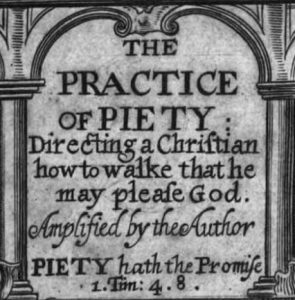 Lewis Bayly’s Practice of Piety is a classic work of doctrine and devotion that demolishes the idea that there’s any division between the two.
Lewis Bayly’s Practice of Piety is a classic work of doctrine and devotion that demolishes the idea that there’s any division between the two.
Those of us who simply love to read theology, more or less for its own sake, sometimes need to be reminded that knowing God has practical ends as well. And those of you (it would strain credibility if I pretended to include myself among the number) who do not make it a habit to read theology sometimes need to be told why it is worth doing.
Bayly is helpful for both, because his Practice of Piety, as the name accurately indicates, is a practical book “directing a Christian how to walk that he may please God.” The only trick (which is not really a tricksy trick but the sober truth) is that in order to know how to walk in the presence of God, you have to know a lot about God. Otherwise you’re just walking. So Bayly starts his practical book with a major dose of highly instructive classical trinitarian theology. It’s a lot of pages of what we call, in the technical language of Christian dogmatics, the good stuff.
He concludes that section by saying, “this is the plain description of God, so far as he hath revealed himself to us in his word,” and immediately identifies “four special uses” which “every true practitioner of piety” stands to gain from knowing and believing this doctrine.
First is the benefit of distinguishing the true God from pretenders:
1. That we may discern our true and only God from all false gods and idols; for the description of God is properly known only to his church, in whom he hath thus graciously manifested himself (Psal. clxvii. 19, 20; Jer. x. 25.)
The second benefit is affective, with our hearts finding their homes in each of the divine perfections. Watch the verbs here:
2. To possess our hearts with a greater awe of his majesty, whilst we admire him for his simpleness and infiniteness; adore him for his unmeasurableness, unchangeableness, and eternity; seek wisdom from his understanding and knowledge; submit ourselves to his blessed will and pleasure; love him, his love, mercy, goodness, and patience; trust to his word, because of his truth; fear him for his power, justice, and anger; reverence him for his holiness; and praise him for his blessedness: and to depend all our life on him, who is the only author of our life, being, and all the good things we have.
Third is our transformation into the likeness of God, which begins with the informing of our understanding and the directing of our desires:
3. To stir us up to imitate the Divine Spirit in his holy attributes, and to bear, in some measure, the image of his wisdom, love, goodness, justice, mercy, truth, patience, zeal, and anger against sin; that we may be wise, loving, just, merciful, true, patient, and zealous, as our God is.
And fourth is to guide our prayer correctly to God as he is, and drive away superstition imaginings of God as he isn’t:
4. Lastly, that we may in our prayers and meditations conceive aright of his divine majesty, and not according to those gross and blasphemous imaginations which naturally arise in men’s brains, as when they conceive God to be like an old man sitting in a chair; and the blessed Trinity to be like that tripartite idol which papists have painted in their church windows.
Check out Bayly’s Practice of Piety. Here, read Charles Wesley’s copy of it.